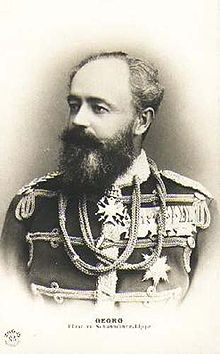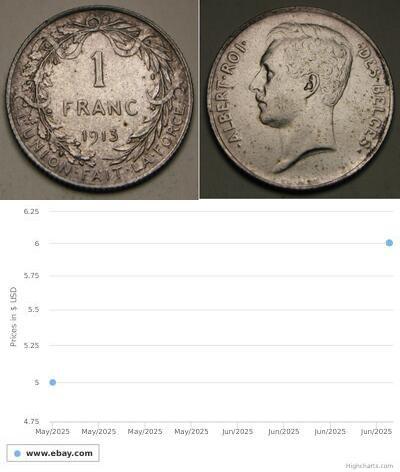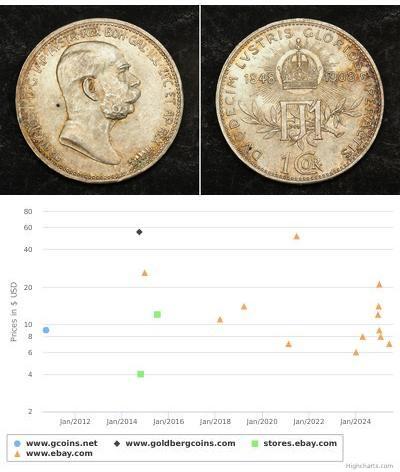3 Mark
1911, Schaumburg-Lippe (Principality), Georg I. Silver 3 Mark Coin. PCGS MS-61!
Mint Date: 1911
Reference: KM-55.
Mintage: 50,000 pcs.
Mint Place: Berlin (A)
Denomination: 3 Mark - Death of Prince Georg I.
Condition: Certified and graded by PCGS as MS-61!
Weight: 16,67gm
Diameter: 33mm
Material: Silver
Obverse: Bearded bust of Prince George I left. Mint initial (A) below bust truncation. Dates of birth and passing below.
Legend: GEORG FÜRST ZU SCHAUMBURG LIPPE / * 10 X 1846 + 29 IV 1911
Reverse: Crown of the German Empire above heraldic eagle of Germany with prussian shield at chest and star order.
Legend: DEUTSCHES REICH 1911 * DREI MARK *
 Schaumburg-Lippe was created as a county in 1647, became a principality in 1807, a free state in 1918, and was until 1946 a small state in Germany, located in the present day state of Lower Saxony, with its capital at Bückeburg. Schaumburg-Lippe was formed as a county in 1647 through the division of the County of Schaumburg by treaties between the Duke of Brunswick-Lüneburg, the Landgrave of Hesse-Kassel and the Count of Lippe. The division occurred because Count Otto V of Holstein-Schaumburg had died in 1640 leaving no male heir. Initially Schaumburg-Lippe's position was somewhat precarious: it had to share a wide variety of institutions and facilities with the County of Schaumburg (which belonged to Hesse-Kassel), including the representative assembly and the highly productive Bückeberg mines, and the Landgrave of Hesse-Kassel retained some feudal rights over it. It was further threatened by the headstrong policies of ruling Count Friedrich Christian. To counter these threats, Friedrich's grandson Count Wilhelm (who reigned 1748–1777) retained a standing army of up to 1000 troops - quite a lot for such a small territory. With Wilhelm's death in 1777 the junior Schaumburg-Lippe-Alverdissen inherited the County thereby reuniting Schaumburg-Lippe with Lippe-Alverdissen. Schaumburg-Lippe was a county until 1807 when it became a principality; from 1871 it was a state within the German Empire. In 1913, it was the smallest state in the German Empire in terms of population. The capital was Bückeburg, and Stadthagen was the only other town. Under the constitution of 1868, there was a legislative diet of 15 members, 10 elected by the towns and rural districts and 1 each by the nobility, clergy and educated classes, the remaining 2 nominated by the prince. Schaumburg-Lippe sent one member to the Bundesrat (federal council) and one deputy to the Reichstag. It lasted until the end of the German monarchies in 1918, when it became a free state as the Free State of Schaumburg-Lippe. In November 1918, Prince Adolf was the second last reigning German monarch to abdicate.
Schaumburg-Lippe was created as a county in 1647, became a principality in 1807, a free state in 1918, and was until 1946 a small state in Germany, located in the present day state of Lower Saxony, with its capital at Bückeburg. Schaumburg-Lippe was formed as a county in 1647 through the division of the County of Schaumburg by treaties between the Duke of Brunswick-Lüneburg, the Landgrave of Hesse-Kassel and the Count of Lippe. The division occurred because Count Otto V of Holstein-Schaumburg had died in 1640 leaving no male heir. Initially Schaumburg-Lippe's position was somewhat precarious: it had to share a wide variety of institutions and facilities with the County of Schaumburg (which belonged to Hesse-Kassel), including the representative assembly and the highly productive Bückeberg mines, and the Landgrave of Hesse-Kassel retained some feudal rights over it. It was further threatened by the headstrong policies of ruling Count Friedrich Christian. To counter these threats, Friedrich's grandson Count Wilhelm (who reigned 1748–1777) retained a standing army of up to 1000 troops - quite a lot for such a small territory. With Wilhelm's death in 1777 the junior Schaumburg-Lippe-Alverdissen inherited the County thereby reuniting Schaumburg-Lippe with Lippe-Alverdissen. Schaumburg-Lippe was a county until 1807 when it became a principality; from 1871 it was a state within the German Empire. In 1913, it was the smallest state in the German Empire in terms of population. The capital was Bückeburg, and Stadthagen was the only other town. Under the constitution of 1868, there was a legislative diet of 15 members, 10 elected by the towns and rural districts and 1 each by the nobility, clergy and educated classes, the remaining 2 nominated by the prince. Schaumburg-Lippe sent one member to the Bundesrat (federal council) and one deputy to the Reichstag. It lasted until the end of the German monarchies in 1918, when it became a free state as the Free State of Schaumburg-Lippe. In November 1918, Prince Adolf was the second last reigning German monarch to abdicate.
Authenticity unconditionally guaranteed.
 Georg, Prince of Schaumburg-Lippe (10 October 1846 – 29 April 1911) was a ruler of the small Principality of Schaumburg-Lippe.
Georg, Prince of Schaumburg-Lippe (10 October 1846 – 29 April 1911) was a ruler of the small Principality of Schaumburg-Lippe.
He was born in Bückeburg to Adolf I, Prince of Schaumburg-Lippe and Princess Hermine of Waldeck and Pyrmont (1827–1910).
He succeeded as Prince of Schaumburg-Lippe on the death of his father on the 8 May 1893 and reigned until his death on the 29 April 1911 at Bückeburg and was succeeded by his son who became Adolf II.
On the occasion of their silver wedding anniversary in 1907, Emperor Wilhelm II presented to Georg and Marie Anne the family ancestral seat, Schaumburg Castle. The castle had been controlled by the Hohenzollerns ever since Georg's grandfather sided with the Austrians in the 1866 Austro-Prussian War. The gift was also meant to be in recognition of Georg's support in the dispute over the succession to the Lippe-Detmold throne.

-600-300-9wghwJfl09QAAAGLO0VTnYJi.jpg)


-300-150-9wghwJfl09QAAAGLO0VTnYJi.jpg)
 English
English











